An Example Given of Taste Aversion Was and Then Refusing to Eatdrink It Again

This Article From Event
May-June 2015
Book 103, Number 3
Imagine that you lot are dining at a familiar restaurant, and you order a new particular on the menu—something that you've never tried before—and afterwards that night you lot go violently sick. What caused you to get sick?
Your affliction could have been caused by a touch on of the flu, a familiar nutrient that was poorly preserved or prepared, an exposure to a toxin, or a favorite cocktail interacting badly with some medication taken earlier in the day. Only fifty-fifty if you lot are aware of these and other alternative possibilities, there is a loftier probability that you will blame the novel dish for your illness. Indeed, the taste, and even the thought, of that new bill of fare particular may later on make your stomach plow, and you may decide never to eat that food once again.
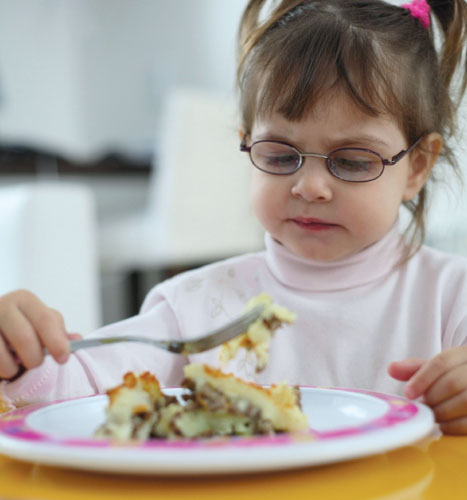
OJO Images Ltd/Alamy
No dubiety many of usa have had this type of experience. Why are we so quick to place the blame for sickness on a novel-tasting food instead of blaming many other equally plausible possibilities? You may be thinking that blaming the unfamiliar food is the near logical response, only why does it seem that way? We've eaten new things many times before without condign ill, and nosotros've become ill before without eating anything new. What makes the connectedness between a novel taste and disease so strong that information technology tin override these other types of experiences?
Answers to these questions, likewise as show for the reality of the phenomenon itself, were found not in anecdotes only in the results of experiments. Those results shook the foundations of psychology as it existed at the time, and led to a paradigm shift in thinking about how humans and other animals learn in full general, and about the conditions nether which learning occurs. Our group and others are nonetheless exploring the implications of those findings today.
Studies of what would later be termed conditioned taste aversions date back to at to the lowest degree the 1940s. I of the first of these investigations was conducted in support of the British state of war effort by Charles Elton of the Bureau of Brute Population. In an endeavor to develop procedures for the eradication of rats and mice from foxholes and beachheads, Elton and his swain researchers observed the consequences when rats and mice consumed poisoned baits. In these studies, the rodents would oft sample the baits simply they would eat only small amounts. This reluctance served to protect the rodents from death, but did not spare them from a rather intense poisonous substance-induced illness. After recovering from this toxicosis, the rodents stopped consuming the poisoned baits. This same strategy in the field would have the rats and mice avoiding foods associated with poison, but they would persist past living off other available foods. Julian Rzóska, one of the investigators in the research effort, surmised that the animals learned that the base of operations food in which the poison was embedded made them ill and then they avoided the nutrient on subsequent exposures.
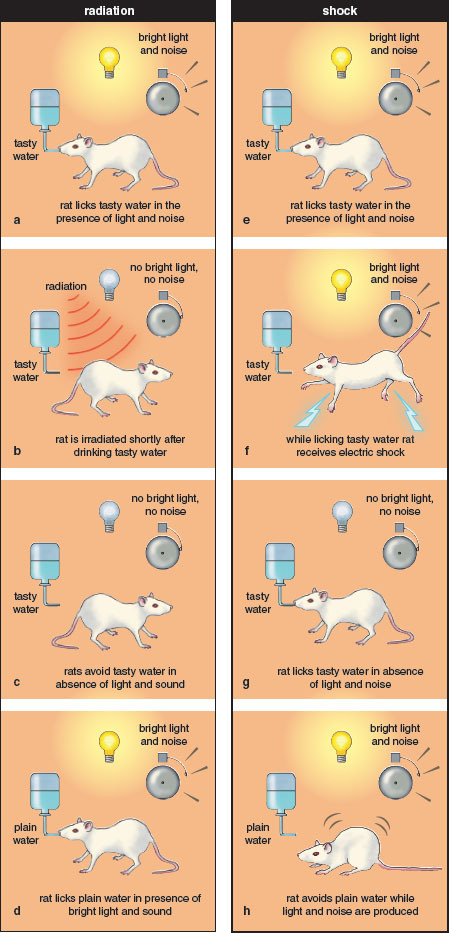
Illustration by barbara Aulicino.
In the 1950s, John Garcia demonstrated conditioned taste aversion under quite different laboratory conditions and came to realize that the phenomenon represented much more a potential means of improving pest control. Early in 1951, Garcia left graduate school at the University of California, Berkeley, and began working at the U.s. Naval Radiological Defense force Laboratory at Hunters Point in San Francisco, where he used the rat as a model to study the effects of exposure to radiation on living systems. He noted that rats given water in plastic bottles prior to the induction of radiation sickness later avoided drinking water from those bottles. The same rats would beverage the water if information technology was provided in glass bottles. Garcia and his colleagues speculated that the plastic containers may have given the h2o a novel taste that the rats associated with the subsequent sickness. Garcia tested this thought by giving rats a novel sweet-tasting saccharin solution during radiation exposure. Equally expected, when the irradiated rats were tested later, they strongly suppressed intake of the saccharin solution compared to a command group that had non been irradiated later consuming saccharin. The disfavor to saccharin persisted for over a month despite the fact that information technology was acquired afterwards a single pairing of saccharin with radiation.
An observation that immediately struck Garcia was that the rats seldom avoided the compartments in which radiation was delivered, and if they did, such avoidance took longer to establish and was less stable than taste aversion. The important implication of this observation was that non all stimuli (in this case, external environmental cues versus taste cues) were equally associable with radiation sickness.
In a landmark test of this hypothesis, Garcia and his colleague Robert Koelling conducted a written report in which licking a spout non only delivered a saccharin solution but also activated a flashing light and a clicker. During exposure to this "tasty/bright-noisy water," the rats were irradiated. In the test phase, animals that were given the tasty/bright-noisy water compound paired with irradiation avoided consuming the saccharin solution when information technology was subsequently presented without the flashing low-cal and clicker. All the same, the same rats connected to lick the tube when it no longer contained saccharin, just licking still produced the light flash and click. These results showed that sweetness sense of taste was much more strongly associated with radiation sickness than were the light and clicker even though pairing with illness was equated for all three types of stimuli.
Interestingly, when these same stimuli were paired with electrical shock in other groups of rats, only the audiovisual cues, and non the sweet taste, caused the ability to suppress licking. From these results, Garcia argued for a selectivity of learning in which tastes were preferentially associated with sickness and auditory and visual cues were preferentially associated with shock. That is, learning not only depended on pairing a cue with a effect, it also depended on which specific types of cues were paired with which specific types of consequences. This conclusion contrasted with the prevailing views, which considered all types of stimuli and consequences to be equally associable.
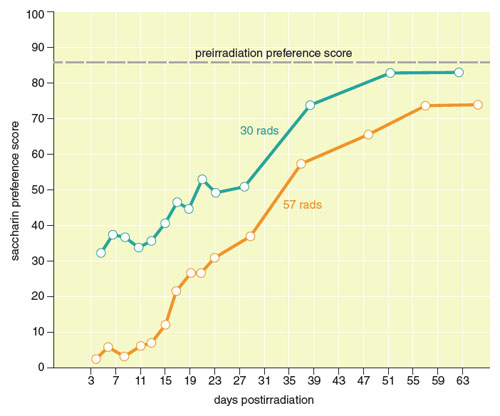
Data adapted by Barbara Aulicino from J. Garcia et al., 1955..
Garcia and his colleagues confirmed some other atypical characteristic of gustatory modality disfavor learning when they showed that rats given saccharin to drinkable followed by drug-induced disease (vomiting acquired by an injection of apomorphine) acquired an disfavor to the saccharin solution fifty-fifty when the injection was delayed by equally long as 75 minutes after consumption of saccharin. Such long-delay learning also contrasted sharply with the widely held view, based on studies in which auditory or visual cues were paired with nutrient or shock, that little or no learning would occur with delays greater than seconds.
The findings that strong gustation aversions could exist acquired after merely one pairing of a taste with illness, that tastes compared to other external cues seemed to be selectively associated with disease, and that gustatory modality-illness associations could be formed over long delays, violated what others believed to be the laws of learning. Garcia farther antagonized the largely behaviorist establishment at the time by arguing that evolution had shaped these characteristics. Specifically, the ability to associate a taste with the furnishings of poisoning afterward a single exposure was highly adaptive in that it enabled animals to avert the potentially fatal consequences of repeated sampling of toxins. Given that affliction is oft produced past toxic plants or decaying meat, animals that were able to selectively associate tastes with illness were at an evolutionary advantage. And chances of survival were as well increased by the power to bridge temporal gaps between ingestion of foods and the delayed onset of illness that resulted from the deadening absorption of toxins during the normal digestive process.
Prevailing learning theories made no accommodations for such adaptive specializations. Equally a upshot, taste aversion learning and its estimation were met with skepticism. For example, Garcia's finding of selective association (the vivid/noisy water experiment) was rejected past several journals, every bit were several of his other initial findings. Garcia subsequently handled such reactions quite humorously, calling editors and reviewers "neophobic creatures" that were reacting more to the novelty of his findings than to their scientific merit or theoretical implications.
Although such reactions slowed the acceptance of Garcia's piece of work, the robustness of conditioned taste disfavor learning and its replicability by other researchers helped to overcome this initial reticence. Moreover, the challenges to learning theory initially posed by Garcia's findings and ideas before long extended well beyond conditioned taste disfavor. Information from many laboratories began to accumulate that showed that behaviors could be learned either very speedily or merely with slap-up difficulty, if at all, dependent on how well the task parameters and response requirements matched a given animal's natural history and behavioral repertoire.
With and then many examples from other domains, gustation aversion learning could no longer be viewed as an bibelot. Instead, it became the foundation for the fledgling view that in that location are biological constraints on learning. This view proposed that although learning itself is a full general phenomenon, information technology could be constrained or facilitated based on the natural history of the creature, and that theories of brute learning and conditioning had to accept that natural history into account. Thus, taste disfavor learning lost its unique condition and was seen instead as one of many unlike learning phenomena that demonstrated a fundamental office for evolution in beliefs.
Although it was clear that development forged fundamental learning processes that were shared by many species, it was also recognized that the details of learning for any private species could differ based on the demands encountered during that species' evolutionary past. The blending of biological science and psychology has led to the widespread acceptance of the idea that behavior is the product of an interaction involving both an fauna'southward private (ontogenetic) and species (phylogenetic) histories.
Showtime in the centre of the 1970s, principles that had emerged from the earlier studies of gustatory modality disfavor learning were applied to a variety of other issues. That is, taste aversions were non being studied only to further characterize the miracle just as well to explore ways in which it could be used to understand and treat a host of other behavioral issues. Such applications have included its utilize in studying acquired nutrient aversions and preferences during pregnancy, changes in food preferences accompanying cancer development, the biological and neurochemical arbitration of learning and memory, the control of attacks on domesticated animals by natural predators, the nature of and command of immunosuppression, and the side effects associated with chemotherapy.
The work of Ilene Bernstein and her collaborators at the University of Washington in the belatedly 1970s provides an important example of this latter application. Bernstein noted that children undergoing chemotherapy frequently acquired aversions to the food they consumed around the time of drug treatment. To substantiate these informal observations, Bernstein gave children a novel food (a unique-tasting ice cream) immediately prior to receiving chemotherapy and found that they decreased their consumption of the water ice cream when they had the opportunity to consume it once again, compared to children that received no chemotherapy or that received chemotherapy that was not paired with the ice cream.
Chemotherapy had less impact on children's normal diet when a novel food was given during a session.
This issue showed that the pairing of the novel ice foam with chemotherapy was sufficient to condition an aversion and provided an explanation for why children undergoing chemotherapy exhibited changes in food preferences. Importantly, work from other animal models gave insight into ways to reduce or eliminate such aversions and amend this ofttimes-reported side issue of chemotherapy. Specifically, novel foods had been reported to have a higher likelihood of being associated with illness than more familiar ones. This very aforementioned premise was used by Bernstein and her colleagues to demonstrate that chemotherapy had a lessened impact on the children's normal diet when a novel food was given during the chemotherapy session. In other words, when the children ate a novel food such every bit the ice foam prior to therapy instead of a familiar one, there was an increased likelihood that the novel food, and not foods from their normal nutrition, would be associated with the illness. This creation of a dietary scapegoat precluded the avoidance of essential and familiar components of the child's diet.
The same machinery of forming a food aversion from pairing a specific taste with gastrointestinal illness turns out to take a parallel positive outcome of forming food preferences, when a taste or flavor is paired with a nutritive or caloric heave in the digestive system. This latter blazon of learning has been assuredly demonstrated by Anthony Sclafani and his associates at Brooklyn Higher-CUNY. That team used what Sclafani termed the "electronic esophagus," which paired the oral intake of a non-nutritive flavor with gastric infusion of a nutrient (a fat or sugar solution) that completely bypassed the oral fissure, nonetheless yielded a strong learned preference for the paired flavor. This upshot does not seem very different from the formation of a food disfavor produced by pairing oral consumption of a non-nutritive gustation with the intraperitoneal injection of a toxin, in that both the preference and the aversion are based on pairing orally consumed stimuli with postal service-ingestion consequences. Moreover, just every bit learned nutrient aversions can exist seen as performing an adaptive function past protecting animals from ingesting harmful substances, food preference learning tin be seen as adaptive by promoting intake of substances that are needed to sustain life. So, we wondered, what would be the consequences of interfering with each of these adaptive functions?
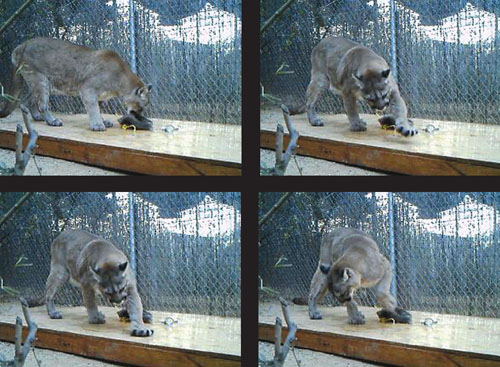
Images courtesy of Neb Given/The Wild Source.
If 1 reduced the power of animals to apply the gustatory modality of a toxic substance to predict subsequent disease, this result would presumably have adverse consequences for survival by increasing the likelihood of poisoning. Too, research we did in collaboration with Susan Swithers and her inquiry group at Purdue University suggests that reducing the ability of tastes to predict caloric outcomes may also produce harmful, just maybe less firsthand, effects on survival. For example, it has oft been proposed that based on the commonly stiff association between sweet taste in the mouth and the arrival of calories in the gut, sweetness tastes acquire the capacity to evoke a number of preparatory physiological responses that promote efficient energy use. Given this office, i might expect that experiences that weaken the sweet taste–calorie clan should also interfere with energy and torso weight regulation. One manner to weaken the adaptive sweetness gustatory modality–calorie association would be to consume noncaloric sweeteners, which would involve exposure to sweet gustatory modality that is not followed by calories. A multifariousness of experiments with rats have provided support for this hypothesis past showing that exposure to noncaloric sweeteners is followed past increased weight gain and weaker command of the intake of caloric sugars. A 2014 review by Swithers shows that similar adverse effects of consuming noncaloric sweeteners have been reported for humans. Thus, both rodent and human data propose that obesity and its associated issues may be adverse health consequences of weakening the sweet taste–calorie association.
The natural language is non the but role of the torso with the ability to gustatory modality, and hence to play a role in sense of taste disfavor. Recent findings plant that basic taste stimuli (such every bit sweet and bitter) are detected in the gastrointestinal tract using taste receptors and chemosensory signaling pathways that are much the same as those that are used by the tongue. Andrea Tracy, and after Lindsey Schier, led investigations at Purdue University that provided show that gastrointestinal tastes, like orally detected tastes, can be associated with toxicosis, and that those associations could modify ingestive behavior.
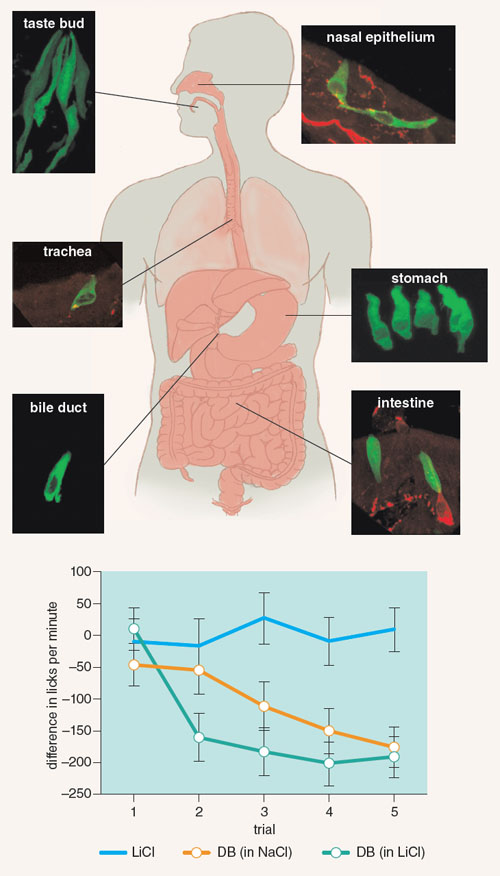
Illustration adapted by Barbara Aulicino from R. East. Finger and South. C. Kinnamon, F1000 Biology Reports 3:twenty. Micrographs courtesy of Marco Tizzano. Graph information adapted from L. A. Schier et al., 2011.
Tracy showtime confirmed Sclafani's before findings that rats learned to prefer an orally consumed not-nutritive flavor (such as orange and cherry) that was paired with infusions of nutrients (carbohydrate or fatty emulsions) directly into the gastrointestinal tract, relative to flavor cues that were paired with water, despite the fact that the commitment of the nutrient emulsion completely bypassed the oral cavity. She so paired one combination of oral flavour and abdominal nutrient infusion (such as cherry and fat) with illness induced by injections of lithium chloride (LiCl), and the other compound (such equally orange-carbohydrate) with saline injections as a control. Equally expected, intake of the oral season paired with LiCl was reduced compared to the flavour paired with saline when those flavors were presented without nutrient infusions. But in add-on to this standard conditioned sense of taste aversion, when given the opportunity to consume the gastrointestinal-infused nutrients by mouth without the flavors, Tracy also found what appeared to be an intestinal taste disfavor. Specifically, the rat's preference for the LiCl-paired nutrient emulsion was significantly reduced compared to the saline-paired emulsion, despite the fact that neither nutrient had made contact with oral taste receptors during pairing with LiCl. Apparently, what was learned about nutrients detected solely in the gut modified the ingestive behavior of the rats when they had their commencement opportunity to orally consume each nutrient. She subsequently showed that rats could learn not just almost nutritive abdominal stimuli but besides near non-nutritive abdominal flavor cues, if those flavors had been previously infused into the gut in chemical compound with nutritive solutions.
Schier extended these findings past establishing abdominal taste aversion learning in studies that assessed rapid, moment-to-moment changes in ingestive behavior. In one experiment, thirsty rats were trained to lick at a sipper spout for a solution of tabular array common salt (sodium chloride, NaCl). A brief intestinal infusion of either the same salt, or one of the same concentration made with a toxic LiCl solution, was yoked to their licking behavior for the starting time 6 minutes of each 30-minute session. Considering rats were licking for the same NaCl solution at the sipper spout when either NaCl or LiCl was intestinally infused, oral taste cues could non predict the LiCl infusion. Therefore, the rats were not able to predict subsequent malaise by differentiating the intestinal infusion of LiCl from NaCl during the early 6-minute infusion period. Withal, when bitter-tasting denatonium benzoate was laced into the abdominal infusion of LiCl, the rats learned later a single trial to rapidly curb intake within minutes of the infusion, thereby reducing farther aggregating of the malaise-inducing LiCl.
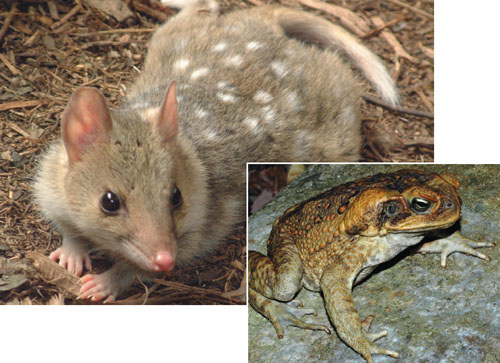
Wikimedia Commons
Intestinal infusions of non-nutritive sweet tastes delivered with LiCl could also reduce ongoing intake if those sweet tastes had previously been mixed with nutritive sugars. Thus, this report showed that intestinal taste aversion learning about an intestinally infused non-nutritive sweet taste could be prompted past preparation it in conjunction with a nutritive sweetener.
This series of experiments confirmed that gustation stimuli are detected past receptors located in the gastrointestinal tract; provided new evidence that these gastrointestinal tastes can be associated, much like oral taste stimuli, with gastric malaise; and the clan of gastrointestinal taste cues with angst can alter both nutrient preference and ongoing ingestive behavior.
Associations betwixt intestinal tastes and either aversive or nutritive post-ingestion consequences could have several functional roles in feeding behavior, such as providing a final line of defense prior to the absorption of significant amounts of toxins, promoting learning nigh oral gustation stimuli by filling the temporal gap betwixt the detection of oral tastes and postingestive outcomes, or contributing to control of digestive processes that may occur well afterward oral consumption has ended.
It does non seem probable that this abdominal taste system evolved every bit a protective machinery that operates independently of oral taste. Gustation stimuli do not ordinarily arrive in the gut without first passing through the oral cavity. Withal, there are weather where this does happen. Tube feeding and the use of medicinal capsules are 2 ways in which tastes could be detected in the gut while bypassing oral sense of taste receptors.
One implication of the above findings is that if these routes of administering nutrients or medications are associated with gastrointestinal malaise produced past other sources, the tastes of the intubated or encapsulated substances could be associated with the illness and thus avoided upon subsequent oral contact. This effect is presumably less problematic when capsules are used to contain bitter tasting substances that would not be well tolerated if consumed orally. All the same, tube feeding provides nutrients and thus the associating abdominal sense of taste of these nutrients with illness might negatively affect their subsequent consumption past mouth afterwards tube feeding is suspended. The implications of this possibility for medical interventions merit additional study. One speculative proposition is that by adding biting taste to intubated nutrients, the clan of the intestinal tastes of the nutrients with illness might be reduced or prevented. Although this approach could increase aversion to bitter tastes, it would accept minimal impact on subsequent oral intake, considering bitter tastes are usually avoided when consumed by rima oris fifty-fifty in the absence of association with illness.
Although the initial work on taste aversion learning focused on illness equally the effect that conditioned such avoidance, in the early on 1970s, a variety of researchers studying sense of taste aversion learning reported that drugs known to exist rewarding in certain contexts were also quite effective in suppressing the intake of fluids with which they had been associated, likely considering of their power to crusade side effects such equally anxiety, airsickness, or drowsiness. The ability of drugs to be both rewarding (supporting cocky- administration) and aversive (inducing a taste aversion) was initially considered paradoxical, or idea to be a part of very different atmospheric condition (such equally unlike doses) used to establish each behavioral effect. Further inquiry, however, indicated that drugs such as morphine, cocaine, amphetamine, and tetrahydrocannabinol (plant in marijuana) were circuitous compounds with multiple stimulus furnishings and, depending upon the behavior being investigated, could induce aversions or preferences.
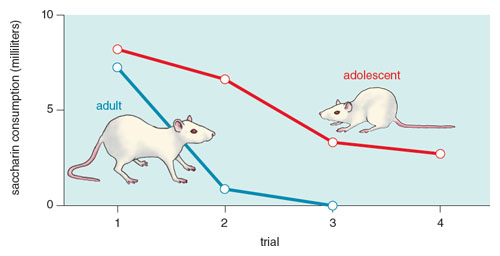
Data adapted past Barbara Aulicino from J. Cobuzzi et al., 2013.
This ability had interesting implications for how these furnishings might interact in whatever specific private to affect drug intake. If drugs such as morphine have both positive and negative furnishings, and then this residuum must play a role in determining the drug'south use. Chiefly, factors that determine each of these affective properties would, in plough, influence the relative balance of the ii, and thus increase or decrease the drug's potential for corruption.
1 such gene that we take investigated with our collaborators at American University in Washington, DC, is drug history. This piece of work has focused on how history with a drug (whether that be prenatal, during maternal rearing, equally adolescents, or equally adults) affects the subsequent rewarding and aversive effects of a drug. Most research on this topic has been on how drug exposure impacts the drug's rewarding effects. For example, if an animal develops tolerance to such effects, information technology may increase intake to recoup for the decrease in the drug reward.
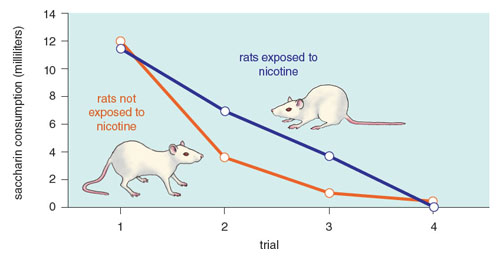
Information adapted by Barbara Aulicino from J. Rinker et al., 2011.
One tin also inquire how changes in the drug's aversive effects can alter drug intake. In this example, a rat'due south connected drug use during machismo significantly decreases the drug's aversive furnishings as the brute adapts to the specific backdrop of the drug, similar to an adaptation that i finds in heroin users and tobacco smokers who report nausea when initially taking the drug, merely not after using it continually for some time. Indeed, drugs that in naive animals can induce pregnant and robust aversions accept little effect in animals pre-exposed to the drug. This pre-exposure effect can be axiomatic even when the two drugs are dissimilar (say, alcohol and cocaine).
Adult rats exposed to nicotine as adolescents find alcohol less aversive than adults exposed to booze alone.
Our group has recently extended these analyses to appraise the furnishings of boyish drug history on drug reward and aversion in adulthood. Boyish rats are interesting in that compared to adults, they are generally more sensitive to a drug's rewarding furnishings and less sensitive to their aversive furnishings, making them much more probable to sample and use such drugs. Given the prevalence of adolescent drug use and the plasticity of the developing brain, we accept asked how an adolescent history with nicotine affects alcohol apply. Using the taste aversion design to assess the drug's aversive effects, we have reported that adult rats exposed to nicotine as adolescents detect alcohol less aversive than adults exposed to alcohol alone, an upshot that can shift the reward/disfavor balance of alcohol and increase its employ and abuse.
Drug history is merely one gene that may affect the relative balance of the drug'southward rewarding and aversive effects, and understanding these various factors and how they may affect this balance may exist important to predicting corruption vulnerability. This work from our laboratory and elsewhere points to a apply of the taste abstention pattern non only for characterizing the nature of aversion learning but too equally a tool in investigating the footing for other behavior, including drug use and abuse.
- Bernstein, I. L. 1978. Learned sense of taste aversions in children receiving chemotherapy. Science 200:1302–1303.
- Cobuzzi, J., K. Siletti, Z. Hurwitz, B. Wetzell, M. Baumann, and A. Riley. 2014. Age differences in (±)three,four-methylenedioxymethamphetamine (MDMA)-induced conditioned taste aversions and monoaminergic activity. Developmental Psychobiology 56:635–646.
- Davidson, T. L., A. L. Tracy, L. A. Schier, and South. E. Swithers. 2014. A view of obesity equally a learning and retentivity disorder. Journal of Experimental Psychology: Animate being Learning and Knowledge forty:261–279.
-
- Freeman, K. B., and A. Fifty. Riley. 2009. The origins of conditioned taste aversion learning: A historical analysis. In Conditioned Sense of taste Disfavor: Behavioral and Neural Processes, eds. South. Reilly and T. R. Schachtman, pp. nine–36. New York: Oxford University Press.
- Garcia, J. 1981. Tilting at the paper mills of academe. American Psychologist 36:149–158.
- Garcia, J., D. J. Kimeldorf, and R. A. Koelling. 1955. Conditioned aversion to saccharin resulting from exposure to gamma radiation. Science 122:157–158.
- Garcia, J., and R. A. Koelling. 1966. Relation of cue to consequence in avoidance learning. Psychonomic Science 4:123–124.
- Garcia, J., F. R. Ervin, and R. A. Koelling. 1966. Learning with prolonged filibuster of reinforcement. Psychonomic Science 5:121–122.
- Hinde, R., and J. Stevenson-Hinde, eds. 1973. Constraints on Learning: Limitations and Predispositions. New York: Academic Press.
- Riley, A. L. 2011. The paradox of drug taking: The part of the aversive effects of drugs. Physiology and Behavior 103:69–78.
- Rinker, J., M. Hutchison, S. Chen, A. Thorsell, M. Helig, and A. Riley. 2011. Exposure to nicotine during periadolescence or early adulthood alters aversive and physiological effects induced past ethanol. Pharmacology, Biochemistry, and Beliefs 99:seven–16.
- Rzóska, J. 1953. Bait shyness, a study in rat behavior. British Periodical of Animal Behavior i:128–135.
- Schier, Fifty. A., T. 50. Davidson, and T. L. Powley. 2011. Ongoing ingestive behavior is speedily suppressed past a preabsorptive, abdominal "bitter taste" cue. American Journal of Physiology: Regulatory, Integrative, and Comparative Physiology 301:R1557–1568.
- Schier, L. A., T. L. Davidson, and T. L. Powley. 2012. Rapid stimulus-bound suppression of intake in response to an intraduodenal nonnutritive sweetener afterwards training with nutritive sugars predicting angst. American Journal of Physiology: Regulatory, Integrative, and Comparative Physiology 302:R1351–1363.
- Seligman, Thousand. E. P., and J. Fifty. Hager. 1972. Biological Boundaries of Learning. New York: Appleton-Century-Crofts.
- Swithers, S. Due east. 2013. Bogus sweeteners produce the counterintuitive effect of inducing metabolic derangements. Trends in Endocrinology and Metabolism 24:431–441.
- Tracy, A. L., and T. Fifty. Davidson. 2006. Comparison of nutritive and nonnutritive stimuli in intestinal and oral conditioned taste aversion paradigms. Behavioral Neuroscience 120:1268–1278.
- Tracy, A. Fifty., R. J. Phillips, M. G. Chi, T. Fifty. Powley, and T. L. Davidson. 2004. The gastrointestinal tract "tastes" nutrients: Evidence from the intestinal taste aversion paradigm. American Journal of Physiology: Regulatory, Integrative, and Comparative Physiology 287:R1086–1100.
olivarezinesepark.blogspot.com
Source: https://www.americanscientist.org/article/taste-sickness-and-learning
0 Response to "An Example Given of Taste Aversion Was and Then Refusing to Eatdrink It Again"
Kommentar veröffentlichen